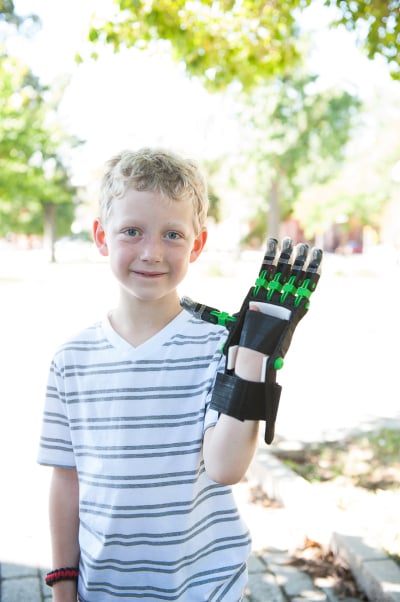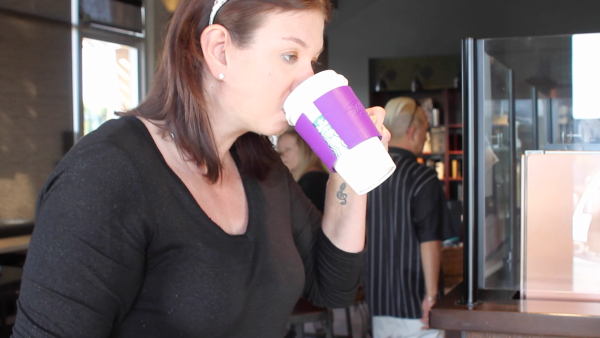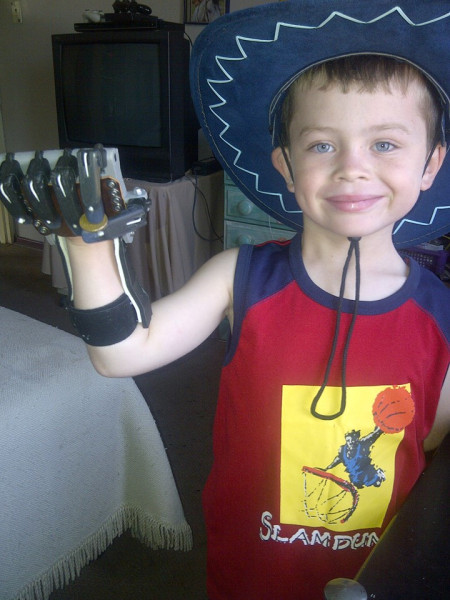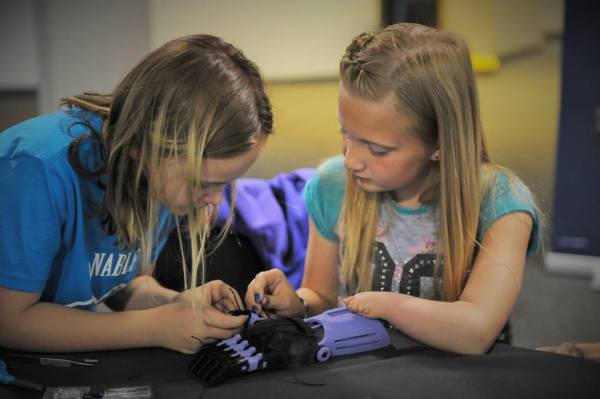
This article originates from Women In 3D Printing and is part of our effort to support the use of 3D printing technology by women. The article is re-published with permission.
Something really exciting is happening right now in the 3D printing industry. It’s called the Within Reach Design Challenge (#WithinReach3DP Challenge on social media).
It is a collaboration between open source prosthetic design organization enablingthefuture.org, 3D printing retailer and developers of MatterControl MatterHackers, 3D printer manufacturer Ultimaker and 3D design marketplace Pinshape.
The core team behind the challenge is composed of 4 women: Mara Hitner, Jen Owen, Lauren Watkins and Laura Galloway. It all started with Mara’s best friend, Brandy Leigh Scott, who was diagnosed with a condition called Dupuytrens Contracture. Due to this condition, her hands are becoming irreversibly closed into fists. Mara, who has been utilizing 3D printing to help her friend, started talking with Jen, Lauren and Laura, and they came up with the #WithinReach3DP challenge to help more people suffering from paralyzing conditions such as Brandy’s.
You can find more information about Brandy’s story and how the challenge started by watching this video.
Nora Toure: enablingthefuture.org, Pinshape, MatterHackers and Ultimaker teaming up for #WithinReach3DP. Why is it making sense?
Jen Owen, e-NABLE: In the e-NABLE Community, you have thousands of volunteers, students, teachers and makers from all different backgrounds, races, religions and expertise, who are coming together to collaborate from every corner of the world to share their ideas on how to solve real world problems – like free and low cost assistive devices for those who are missing or who have lost their fingers and arms below the elbow.
In Ultimaker, you have a leading 3D printer company who not only creates high quality, beautiful 3D printers – but who supports and encourages schools and makers all over the world, to think of ways they can use their talents and skills and bring their ideas to life, and has been a leading supporter of the global e-NABLE Community from the very start of the e-NABLE project.
In MatterHackers, you have a company that is passionate and knowledgeable about 3D printing technology who is showing makers and future makers how they can use these machines to do much more than simply printing out toys and trinkets for themselves, and instead helping to spread the core message of e-NABLE – that when makers combine forces, no matter what printer or software they are using – they can help change lives.
In Pinshape, you have a company that encourages people to share their ideas with the world and have created a global repository of open source and free 3D printable files so that people who need a 3D printed solution to an everyday problem, can simply search for the item or tool they need, download it and print it out – giving the e-NABLE Community a wonderful way to create collections of tools that can potentially aid thousands of people in need, no matter where they are in the world.

Mara Hitner, MatterHackers: The 3D printing community is full of great companies who excel at what they do, and when we all work together for a common goal, we are unstoppable. This particular partnership came together because MatterHackers had already designed some tools for Brandy, and when Jen from enablingthefuture.org saw that video, she got inspired to transform it into an opportunity for her community of people already 3D printing for the good of others in the form of a design challenge. We wanted to offer a meaningful prize, so we approached Ultimaker, who makes a great 3D printer, and was already a partner of both of ours. From there the missing link was a platform to host the contest, and I immediately thought of Lauren at Pinshape, as MatterHackers had supplied prizing for one of their previous contests.
Lauren Watkins, Pinshape: Pinshape was interested in hosting a contest challenging designers to make assistive tools. After chatting with our friends at MatterHackers about the contest, they told me they were already working on something similar so it just made sense to team up.
Laura Galloway, Ultimaker: Ultimaker has had a long standing partnership with e-NABLE, supporting multiple initiatives in the past. MatterHackers, one of our Channel Partners approached us about the Within Reach design contest and it was a no-brainer. Brandy’s story is inspirational and Ultimaker was thrilled to support the Within Reach design contest.
Nora Toure: The #WithinReach3DP project started as a personal initiative brought by Mara, that was then backed by all of you on the business level. Why is this project important for you, personally?
Mara Hitner, MatterHackers: This project was important to me personally because Brandy is my best friend. Most days I literally forget about her hands, she never makes a big deal of it. But once in a while I see her struggle, and it’s hard. Those first few designs that MatterHackers 3D printed for her made such a difference in her daily life, and I got to see that when we would go out to coffee or bars together, travel together…Brandy became our most vocal 3D printing advocate! To think that she will get the benefit of a larger community participating in designing assistive tools inspires me to get the word out in any way I can.
Jen Owen, e-NABLE: I had been emailing back and forth with Mara for months and then one day finally took a look at the video she had linked to in her signature and before the video was even over, I knew that this needed to become the next e-NABLE Challenge. The community had been focusing on making hands for those without fingers, but as the gal behind the curtain of the enablingthefuture.org website, I get countless emails a month, asking for help for those who have fingers but no function…and I immediately emailed Mara and asked her if Brandy would be willing to help me make this a new challenge for the global maker movement!
Lauren Watkins, Pinshape: I am still fairly new to the 3D printing industry but social impact is something that is always on my mind whenever I decide to start working for a new company or on a new project. When I first heard about eNABLE and their community I thought it was a wonderful cause. Since 3D design and 3D printing allows for a high level of customization, it’s easy to see how it would be able to help someone with limited use of their hands.
Laura Galloway, Ultimaker: Being able to help people and make a difference, whether on a personal or professional level is something that is very important to me. The fact that my position at Ultimaker has given me an opportunity to help provide 3D printers to those in need and ultimately make a difference in the lives of thousands of people continues to inspire me on a daily basis.
Nora Toure: Professionally?
Mara Hitner, MatterHackers: I am committed to making 3D printing easier and more accessible for everybody. A design challenge like this opens up the imagination, and helps to answer the question, “Why do I need a 3D printer? What would I do with it?” This is especially important for schools. There are teachers being mandated to get 3D printers, and they have no idea what to do with them, or how they can impact their students. Teaching design and engineer thinking at an early age will transform the next generation of human beings worldwide. They will see something in the world that’s not quite to their needs and say, “Oh, well I’ll just design something better and print it. Of course. What else would you do? I’ve been doing that since 3rd grade!” This native thinking will blow the roof off of what’s possible in the future – from personalized manufacturing to mass product development.

Jen Owen, e-NABLE: I get dozens of emails a week from people who have found enablingthefuture.org and are desperately seeking help for family and friends, co-workers, teachers, veterans and themselves, who still have fingers but have suffered strokes and nerve damage or who struggle with every day tasks due to arthritis or disease and have lost function in their hands and fingers. They have seen the 3D printed hands that have been created by the e-NABLE Community and are hoping with every ounce of hope they have left, that the current full hand designs will help them..but they won’t.
It kills me to have to email them back and tell them how sorry I am that we do not have anything that will help their child, parent or themselves do basic everyday tasks that could be solved “if only there was a tool for that.”
I saw this as an opportunity to put a call out to the incredibly talented designers and future makers in our e-NABLE Community to go beyond making the basic e-NABLE hands and instead, start thinking of ways they could make simple tools for those who still have full hands but no function.
My grandpa is almost 90 years old and used to spend so much time building tiny intricate houses out of wood and stone and countless hours in his garden but due to diabetes and arthritis, he can no longer do many of those things and struggles daily just to hold his fork and feed himself. I am hoping that when this contest is over, I can show him the collections of tools that have been created and let him “Go shopping” for the designs that he thinks he might be able to use and print them out and let him try them.
Nora Toure: You are 4 women at the heart of #WithinReach3DP. Do you believe it is a coincidence?
Mara Hitner, MatterHackers: There are no coincidences! Women are taking over the world! Imagining, planning, producing, promoting, and fulfilling on a major, global project like this takes smart, collaborative people with more heart than time. Perhaps those people could just have easily been male. It did give me pause, with all the talk about women being a minority in tech, when I realized that all four cornerstones of this project were women.
Jen Owen, e-NABLE: I believe that it takes a collective group of people, whether they are male or female, who are passionate about solving real world problems and who are able to use their skills and resources to make positive change happen in the world and that we are all women who fit that description and are working together to see this idea come to fruition.
Nora Toure: Jen, 3D printing hands and arms for those in need of an upper limb assistive device is e-NABLE’s everyday mission. What challenges do you face in achieving this mission?
Jen Owen, e-NABLE: One of the biggest challenges that we face, is that the majority of the people who are in need of the current e-NABLE hands and arms, are in locations where getting a 3D printer or materials to create these devices for people in need or even shipping large numbers of pre-assembled hands for them to distribute, is nearly impossible.
The cost of shipping printers, filament and the hardware needed to assemble these devices to undeserved areas costs more to ship than the donation is worth and they simply can’t afford to accept a donated device or materials to create their own.

When it costs a volunteer over $200 in import taxes just to pick up a package of 3 FREE rolls of donated filament at their postal service carrier, it gets very frustrating and hard to find hope that all of the work that has been done by the e-NABLE Community to create low cost solutions for people in need of upper limb devices, still seems so unattainable for the people in areas of the world who have absolutely no other options available to them.
Some of our e-NABLE Volunteers have started a non-profit called e-NABLE Outreach, that we hope will be able to raise money to start providing the shipping costs to get printers and materials to remote areas where e-NABLE Chapters have formed, so that when companies do offer to donate materials and 3D printers, e-NABLE Outreach can provide the shipping costs so the volunteers will not have to worry about how to pay for retrieving the donations.
Nora Toure: What kind of additional work / editing is required afterwards to make a design a reality for someone with a disability?
Mara Hitner, MatterHackers: I print Brandy’s forceps on my $600 Printrbot using 20 cents worth of filament. I stick a little piece of tape and tacky shelf-covering on the ends. That’s my post-production! Depending on the design, these devices could do the job right off the print bed, or they might need to be sent out as prototypes to places that can make stronger parts out of more durable materials. Really depends on the design and the use-case.
Nora Toure: What do you think of the 3D Printing industry as a whole today? And how would you like to see it evolve?
Jen Owen, e-NABLE: As a whole, I am excited to see so many new companies joining the movement and coming up with new printers that do more, cost less and will allow more people to own and use them.
I am excited about how much the 3D printing industry has already changed over the past few years and how it has greatly improved the education system, gives teachers and students new ways to explore ideas and provides a way for those amazing young inventors to actually see their ideas come to life and then share them and get feedback from others who would have never had the opportunity to see them, had they not been turned into a 3D printable file.
I would love to see more 3D printing companies offering discounts for schools and encouraging makers of all ages to use their printers to come up with designs that can actually make a positive impact on society, as well as contests that encourage the imagination, creativity and art…especially in younger generations. Sadly, art has been removed from many of our public schools and sometimes, like with the e-NABLE Community – a world changing idea can often times be found in the beginnings of a “crazy idea” for an art project…and having the tools available to create those crazy ideas…is imperative to seeing them come to life.
Mara Hitner, MatterHackers: The 3D printing industry is very exciting from the inside, and quite misunderstood from the outside. I would like to see the public conversations evolve from either “3D printing is dead” or “You can 3D print EVERYTHING!” to more specific realities about the technology as it is now, as we do what we can to evolve it. 3D printing is incredibly useful right now for rapid prototyping and product iteration, the democratization of medicine (like e-NABLE and this design challenge), customized design (including food, housing, space station, etc.) and as an engaging way for schools to teach science, math, history, English, writing, engineering…you name it. Kids get psyched about 3D printers. Teachers are amazing at finding creative ways to bring 3D printing into CORE curriculum. They’ve only just begun. Wait till you see what they are coming up with!
Laura Galloway, Ultimaker: I joined the 3D printing industry back in the early 2000’s working at Z Corporation. At that point, 3D printing was used mostly by engineers for rapid prototyping and design evaluation. It’s amazing to see how much 3D printing has changed in 15 years, with the development of the desktop printer, marketed to the consumer and now creating useful tools for people like Brandy. As with any technology, 3D printing will continue to evolve as part quality gets better and printers are more affordable. Professional desktop printers, ‘print farms’ – printing high volumes of good parts at a low cost, will make their way into the enterprise. The accessibility of the technology will continue to improve, as more companies implement professional desktop solutions into their organizations.
Nora Toure: In your opinion, how could we encourage more women to become involved with 3D Printing?

Jen Owen, e-NABLE: I honestly believe that getting more 3D printers into schools and public libraries where all children and young creative minds can have access to them, is going to really start bringing out more of the world’s “hidden gems”, whether they are male or female, but getting them into science, art, and math classes is going to be essential to making sure that we open this opportunity to more girls who are interested in STEM based learning.
While putting a 3D printer into an engineering classroom is important so that they can learn how to use this technology, engineering classes are still predominantly male and unless we give young girls access to these machines in other areas of study, we may be missing out on some incredibly life changing ideas that could potentially help thousands of people all over the world…simply by giving young girls a tool to use that they would not have had access to otherwise.
Mara Hitner, MatterHackers: Just keep telling inspiring stories. That’s how you get anyone involved in anything. For me, 3D printing is not about the size of the nozzle or which design software you use or if it’s open source or not. It’s about what you DO with it. It’s about what’s possible – now and in the future. It’s customized, and it’s personal. 3D printing is about you and what YOU want to print. So, what do you want to print?
Lauren Watkins, Pinshape: By encouraging women to learn about STEM (science, tech, engineering,math) from an earlier age. Organizations like ladies learning code are also wonderful initiatives that focus on women specifically. I think educating kids about CAD design and 3D printing from an early age in general will naturally help with encouraging women to be involved.
Laura Galloway, Ultimaker: Continuing to work to encourage educators to incorporate 3D printing and design into their classes and coursework, and groups such as Maker Girl will help encourage more women to get involved and excited about the possibilities of 3D printing!
If you are interested in learning more about the challenge or even get into it, you have until Sept.6 to upload your designs here.
And don’t forget to join the Women in 3D Printing group on LinkedIn and Facebook. You can also show your support by donating – Your support will help maintaining the activities of this blog and building more events for the community.
Thank you for reading and for sharing!

